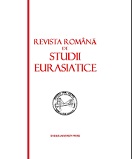SITUATIA PALESTINEI LA FINELE PRIMULUI RAZBOI MONDIAL. CONFERINTA DE PACE DE LA PARIS
THE SITUATION OF PALESTINE AT THE END OF THE GREAT WAR. PARIS PEACE
Author(s): GEORGE VARSAMISubject(s): History
Published by: Ovidius University Press
Keywords: armistice; League of Nations; Covenant of the League of Nations; Faisal; King-Crane Commission.
Summary/Abstract: When the signs of Turkey’s surrender became more than obvious, British diplomatic actions have intensified and Prime Ministers Lloyd George and Clemenceau "have had a bitter correspondence on this theme”. To solve post-war problems, U.S. President Wilson proposed the establishment of the League of Nations. The proceedings of Paris Peace Conference opened on January 18, 1919 but the discussions on the fate of the Ottoman Empire began on January 30 when, Lloyd George proposed to pass its territory under International Mandates System. Article XXII of the Covenant of the League of Nations sanctioned the introduction of mandates’ system, a new international institution for “those colonies and territories which as a consequence of the late war have ceased to be under the sovereignty of the States which formerly governed them and which are inhabited by peoples not yet able to stand by themselves under the strenuous conditions of the modern world”. The Commission of inquiry sent to the Near East (King-Crane Commission) suggested maintaining the unity of Syria together with Palestine and Lebanon, in accordance with the majority of the population’s will. The Great European Powers did not accept the Commission's proposals and passed to the division of spheres of influence in this region. Prime Minister David Lloyd George expressed the hope that Palestine, in its "traditional borders, from Dan to Beersheba", would fall under Great Britain’s influence.
Journal: Revista Română de Studii Eurasiatice
- Issue Year: 7/2011
- Issue No: 1+2
- Page Range: 187-228
- Page Count: 42
- Language: Romanian

